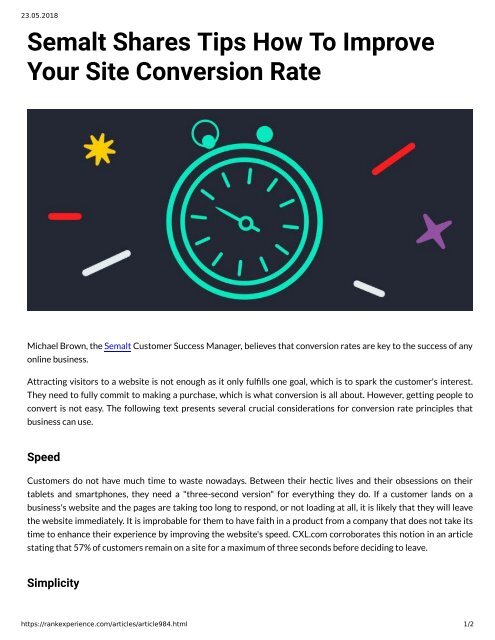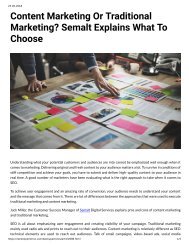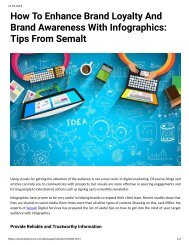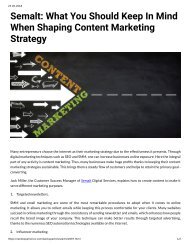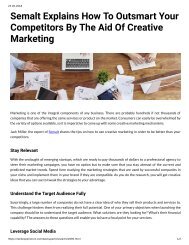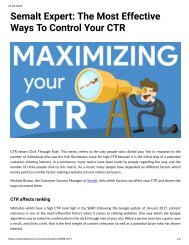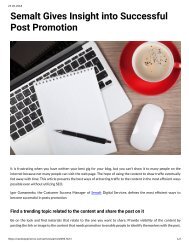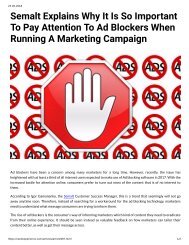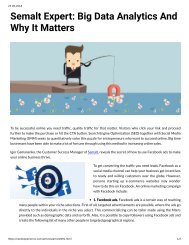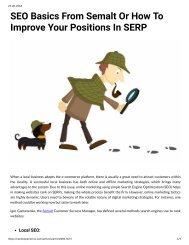984 - Semalt Shares Tips How to Imporve Your Site Conversion Rate
You also want an ePaper? Increase the reach of your titles
YUMPU automatically turns print PDFs into web optimized ePapers that Google loves.
23.05.2018<br />
<strong>Semalt</strong> <strong>Shares</strong> <strong>Tips</strong> <strong>How</strong> To Improve<br />
<strong>Your</strong> <strong>Site</strong> <strong>Conversion</strong> <strong>Rate</strong><br />
Michael Brown, the <strong>Semalt</strong> Cus<strong>to</strong>mer Success Manager, believes that conversion rates are key <strong>to</strong> the success of any<br />
online business.<br />
Attracting visi<strong>to</strong>rs <strong>to</strong> a website is not enough as it only ful lls one goal, which is <strong>to</strong> spark the cus<strong>to</strong>mer's interest.<br />
They need <strong>to</strong> fully commit <strong>to</strong> making a purchase, which is what conversion is all about. <strong>How</strong>ever, getting people <strong>to</strong><br />
convert is not easy. The following text presents several crucial considerations for conversion rate principles that<br />
business can use.<br />
Speed<br />
Cus<strong>to</strong>mers do not have much time <strong>to</strong> waste nowadays. Between their hectic lives and their obsessions on their<br />
tablets and smartphones, they need a "three-second version" for everything they do. If a cus<strong>to</strong>mer lands on a<br />
business's website and the pages are taking <strong>to</strong>o long <strong>to</strong> respond, or not loading at all, it is likely that they will leave<br />
the website immediately. It is improbable for them <strong>to</strong> have faith in a product from a company that does not take its<br />
time <strong>to</strong> enhance their experience by improving the website's speed. CXL.com corroborates this notion in an article<br />
stating that 57% of cus<strong>to</strong>mers remain on a site for a maximum of three seconds before deciding <strong>to</strong> leave.<br />
Simplicity<br />
https://rankexperience.com/articles/article<strong>984</strong>.html 1/2
23.05.2018<br />
Similar <strong>to</strong> the previous principle, people do not have enough time<br />
<strong>to</strong> go through a long, and drawn out presentations. They are only<br />
interested in what the bot<strong>to</strong>m line is for them. It does not mean<br />
that the business cannot entertain them along the way. It only<br />
means that it should avoid long spiels that have the potential <strong>to</strong><br />
lose meaning. Straightforward information has more conversion<br />
rates. Even when using big data, marketers should remember <strong>to</strong><br />
break it down in<strong>to</strong> smaller, understandable chunks.<br />
Laser Focus with CTA<br />
So far, all the principles insist on getting down <strong>to</strong> the bot<strong>to</strong>m line. Even as the business optimizes the content <strong>to</strong><br />
ensure speed and simplicity, it also needs <strong>to</strong> ask for a sale. As a marketer, it beats logic if one expects visi<strong>to</strong>rs <strong>to</strong><br />
convert without requesting them <strong>to</strong> do so. In this regard, a clear and concise call-<strong>to</strong>-action for the landing page<br />
should suf ce. Ironically, several CTA but<strong>to</strong>ns, placed strategically on different pages on the site, are less likely <strong>to</strong><br />
increase conversion rates. A single, well written and brief CTA is enough.<br />
Identify and Analyze the Target Audience<br />
Before doing anything else, marketers should research on whom<br />
the business wishes <strong>to</strong> convert, the intended audience and the<br />
target demographics. There is no point of putting information<br />
haphazardly on the website without clear direction. Once the<br />
research is complete, the marketing team can then tailor all<br />
content in copywriting, social media, blogging, and entire<br />
marketing plan <strong>to</strong> re ect the needs of the target group. By doing<br />
so, it seems <strong>to</strong> cus<strong>to</strong>mers that the intention behind putting the<br />
content there was speci cally aimed <strong>to</strong>wards presenting a<br />
solution <strong>to</strong> their problems. In a word, no matter who the audience<br />
is, nobody likes <strong>to</strong> waste time.<br />
Avoid Going Off Message<br />
After identifying the target audience, marketers need <strong>to</strong> ascertain that the content they provide is cus<strong>to</strong>m <strong>to</strong> their<br />
requirements. In short, everything put out should re ect back <strong>to</strong> the brand. Going astray negatively affects trust<br />
and con dence which results in the loss of cus<strong>to</strong>mers as they remain loyal <strong>to</strong> brands that stick <strong>to</strong> what they promise<br />
<strong>to</strong> deliver.<br />
Conclusion<br />
<strong>Conversion</strong> is the <strong>to</strong> business success, following these principles guarantees that it turns prospects in<strong>to</strong> clients.<br />
https://rankexperience.com/articles/article<strong>984</strong>.html 2/2


